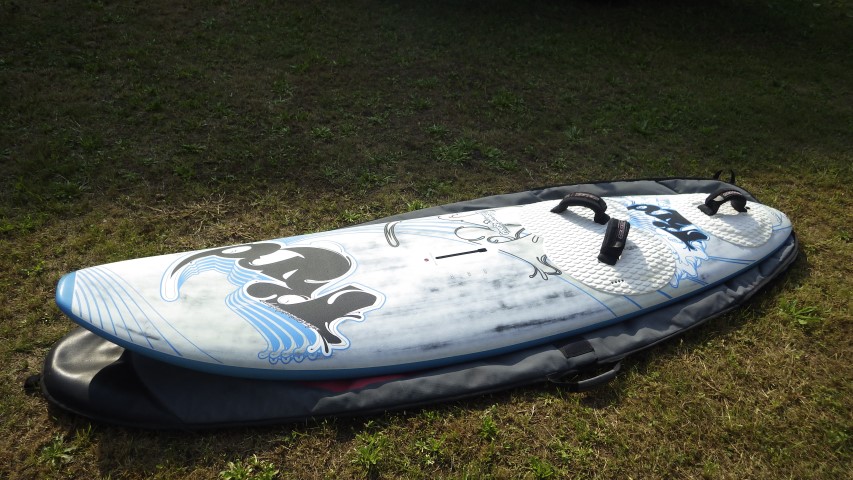We, often, receive lots of desperate requests for help from people who has lately begun windsurfing, and want to buy their equipment, attend a course, or learn a maneuver. In this article, we sum up answers we've given till now, and we provide further suggestions.
Windsurfing: a beginners guide to equipment choice
(Listen to the podcast if you prefer; it is divided into two parts)
Read also the article about recent big volume and entry level freeride boards suitable for beginners.
The first piece of advice that we want to give to those who want to practice windsurfing is to buy soon their own equipment (also used stuff), and spend as many hours as possible in the water.
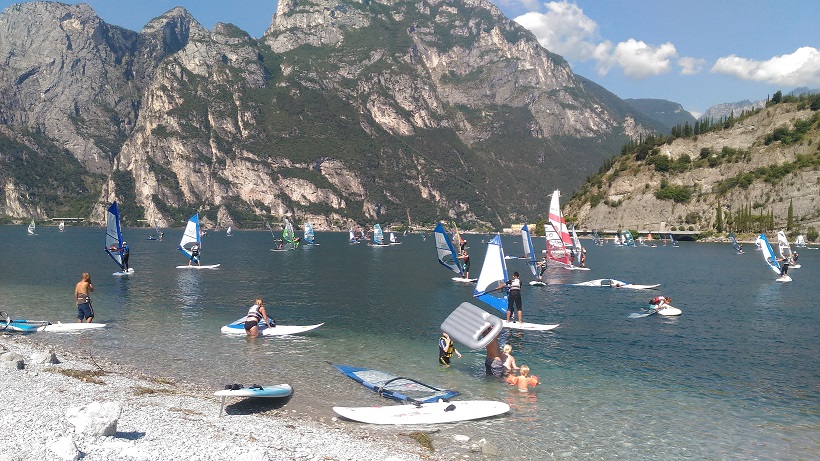
In fact, windsurfing is a sport in which practice is essential to make movement on the board spontaneus and automatic, both while riding and maneuvering. Therefore, only continuous and frequent exercise allows you to achieve this goal. To do this, the availability of your own equipment allows you to do more sessions than you could do, by hiring. This does not mean that, in the very early trials, renting at a good school is the most obvious choice, and is useful for testing and knowing different kind of equipment.
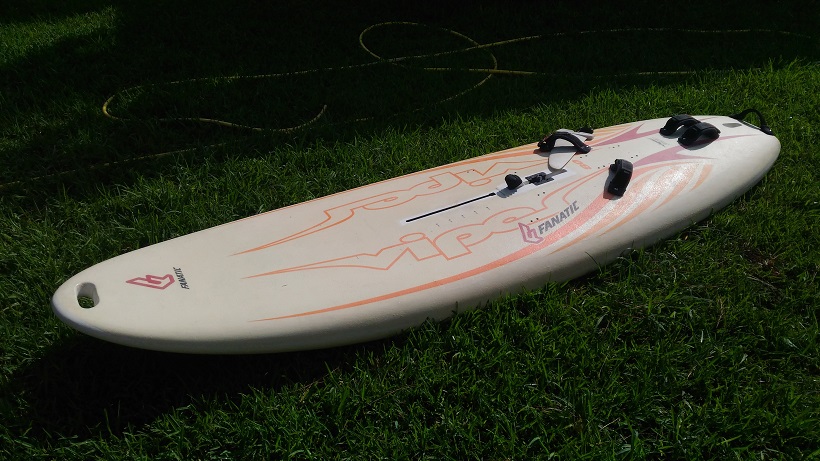
Tips for first gear
The first set of windsurfing equipment, indicatively, should be made up of:
- A board of 180-200 liters, with retractable daggerboard;
- A 5 meters square sail; an SDM mast (Standard diameter mast) suitable for the sail (usually a 430 cm), with a percentage of 60% carbon (it's no use at the beginning to take masts with higher percentage of carbon and more expensive);
- Aluminum boom (also in this case, when you are a beginner, it is unnecessary to take a boom of carbon), with the possibility to adjust the lenght from 150-160 cm to 200-210 cm.
- Adjustable or fixed harness lines, to attach to the boom with harness hook;
- Mast foot; SDM mast extension of 30 or 45 cm;
- Uphaul line to recover the sail from water, to be tighten to mast;
- Neoprene wetsuit suitable for the season, harness, life jacket
In the second hand stuff market, with about 700-800 euros, you can find all the gear listed in 1 to 6; for wetsuit, harness and lifejacket, focusing on new material, you have to account for another 200 to 300 euros (we considered to buy a short or mid-season wetsuit, although for the above explained reasons, we advise you to equip yourself as soon as possible to go out all year long).
We considered a person with an average weight of 70-80 kg. Lighter people (60 kg) can opt for slightly smaller volume boards (160-180 liters). Only for really heavy ones (100 kg) we would recommend beginner boards with volume about of 220 liters, considering the big sizes and weight, and thus the resulting difficulties in transporting such equipment.
All manufacturers have a beginner board model with a retractable daggerboard, and each model is worth it.
Rigid beginner boards are more performing, but they are more manageable by schools that have a fixed location, and they have to move the board only from the storage place to the beach.
Big weight and transport problems of hard board can direct you to purchase of an inflatable windsurf board. Today, some brands (eg Starboard and JP) have developed good and suitable products for beginners, for which inferior performance, especially stability while planing, compared to hard boards, is not important.
Unfortunately, these are recent products (while we are writing - 2017) that are difficult to find in the second hand stuff market and for which you have to be available to pay at least € 500.
In any case, whether it is a rigid beginner board or an inflatable board, we point out the need for the board to be fitted, in addition to the rear fin, also of a central retractable daggerboard (rigid boards) or a central usually fixed (and removable) daggerboard, in the case of inflatable boards. Indeed, beginners tend to drift downwind, and mistakes in maneuvering only make the problem more acute. In addition, inflatable boards, although they are improving much from this point of view, have more rounded rails (side edges) that oppose less resistance to drifting. Therefore, That's why it is important that the board compensates for the more or less beginners inability to ride on the wind (often, also due to the inability to identify the exact direction from which the wind comes).
With regard to the rig (sail, mast, boom), I do not think there is much to say beyond the suggestion above mentioned, except that in the case of children who want to start windsurfing, it is advisable to buy a proper rig, with a 2 or 3 square meters sail, and, above all, with extremely light boom and mast, which can greatly reduce the effort of the youngest. The height of the boom is important: the rig should be of the right size to ensure that the boom reaches the baby's shoulders. A higher boom, for example, means that the child can not effectively resist to the sail power when the gusts arrive.
Advice for purchasing more advanced equipment
For those who have already taken the first steps, or for those who have learned quickly, the beginner board is limiting, and does not allow for further progress, and easy learning of how to plan, first of all because of the weight. Therefore, when you are able to sail close-hauled, to point on the wind, and to bear away at will, to do a basic tack or jibe, you will have the need for a lighter, smaller and more performing board, and a set of at least 2/3 sails.
Typically, the next board to progress further will be a freeride board with a volume of about 140-150 liters (always considering a rider of 70-80 kgs). For lighter people, a 130 liters board is enough; for the heaviest ones (90-100 kg), maybe, a 160 liters board should be better.
As for the models, the choice is wide. Here is an example list:
- Tabou Rocket
- RRD Firemove, RRD Z ride or fireride (firemove, newer and more expensive)
- Starboard GO, AtomiQ or Carve
- Jp Magic Ride, or X-Cite Ride
- Fanatic Gecko
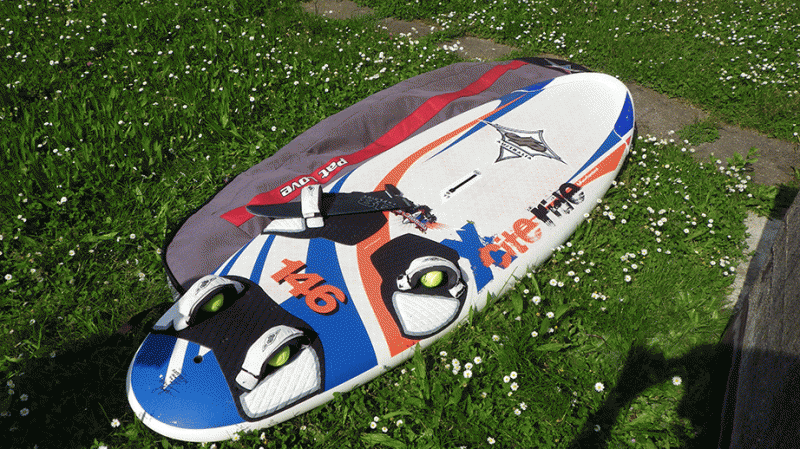
If you want to have a general overview of the latest freeride products from different brands, or if you want to understand the different performances of the boards, you can read this article on 2017 freeride models. Among different boards, it is better to choose, at this level, those that allow to position the straps in many different positions, so as to set them more central and advanced at the beginning, and then more lateral and backward, when you improve your style.
Recently, freeride boards have become wider and wider (80-85 cm), compared to freeride boards of a few years ago (70-75 cm). This let the boards the get planing more easily, and are more stable while riding and maneuvering. Personally, however, I think that if these boards are not also short (eg Starboard AtomiQ), in the choppy conditions, they tend annoyingly to bump on chops.
At this level, unless you have a substantial budget (but, in any case, it would be wasted money), I do not consider necessary to buy the stiffer and lighter Carbon version ("Light") of the board, wich gives additional facilitation get planing. You would generally not be able to fully exploit the potential of this kind of board.
As for the sails, since your sessions will still happen with a wind intensity of no more than 20-25 knots, I would suggest starting with a sail of 6-7 square meters (always freeride, or allround), and one on 5-5.5 square meters (weight rider always about 70-80 kg). The lighter riders will choose for sails in the lower limit of the above ranges.
The largest and most powerful sail will help you to get and manage the first planings, with wind intensities around 15-18 knots. The smaller one will be needed you if you want to go out with 20 - 25 knots (but arrive at this goal, step by step), or with very light winds, to perform very didactic tricks (eg back-winded sailing, clew first sailing, hely tack), propedeutics to learning more advanced maneuvers. I would still remain on an aluminum boom with size corresponding to the chosen sails, and masts with carbon percentages of 60-80%. Instead, for the mast that you need to rig the smaller sail, I would choose a more tough reduced diameter mast (rdm), and which you also could use for several years.
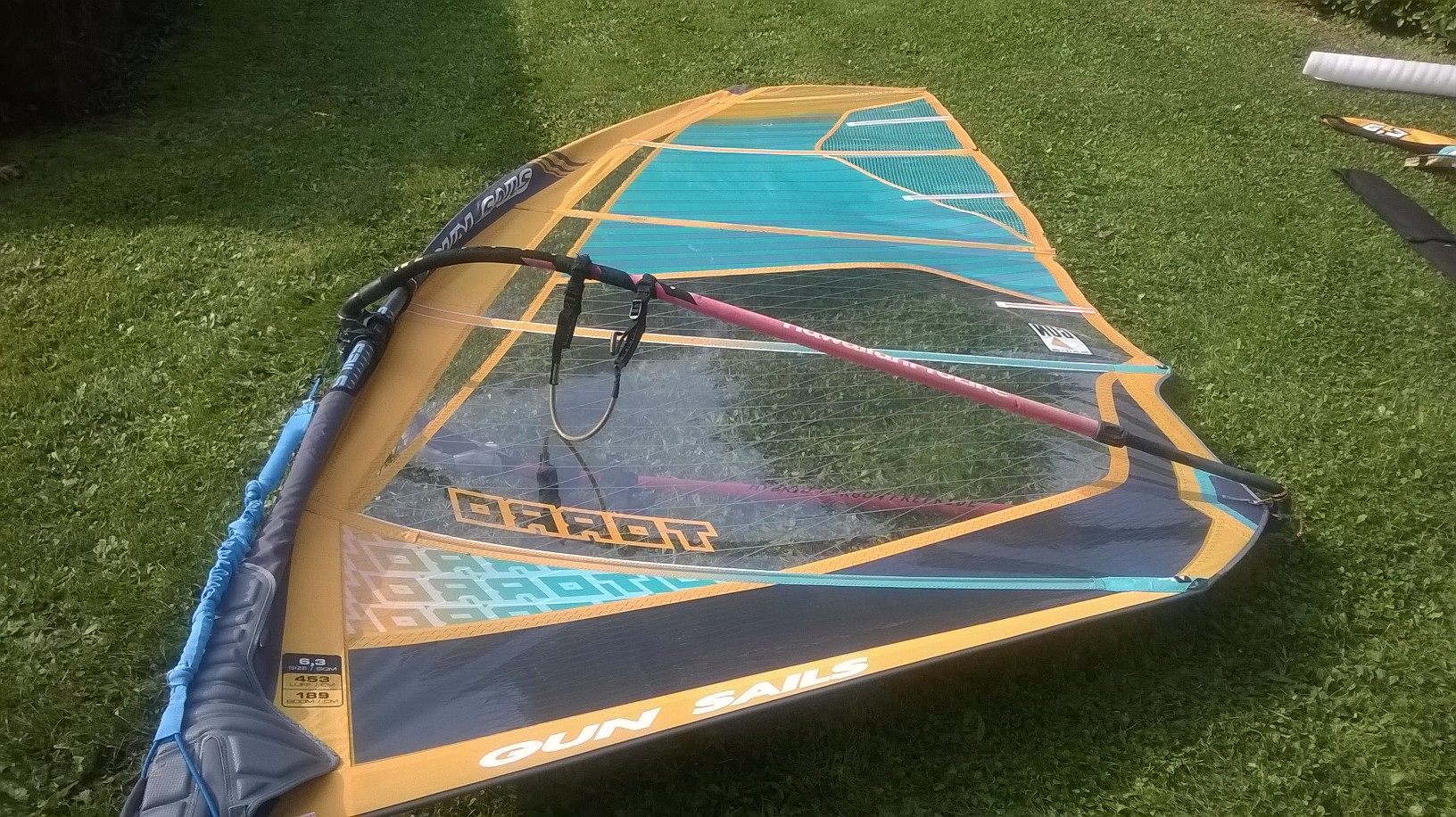
Especially in case of lightweight riders, who start windsurfing when they are young, the first board is immediately a low volume one, about of 120-130 liters. If these beginners, then, show to be fast to learn, they quickly pass to modest volume boards (90-110 liters), maybe with a freestylewave shape.
Apart from these specific cases, usually those who have learned to plan and maneuver decently on a medium volume freeride board will have to choose what to do in their future, also because, maybe, they will begin to want to ride in sea spots, with the first small waves.
In addition, especially when the water level is too choppy or with waves, and when the wind exceeds 20-25 knots, boards with volume higher than 120-130 liters, with fins longer than 30 cm, become less comfortable, because they oppose too much resistance in the water (you will have the feeling of a very "hard" board under your feet), and because they are difficult to manage in maneuver. So, inevitably, it is necessary to go down with volume, and perhaps to change shape.
For those who do not want to pass to the slalom boards (because speed is not their passion), we highlight this detailed article on the peculiarity of freestylewave and waveboard.
It is also important to point out that to ride with lower volume boards, it is compulsory to learn the waterstart. In fact, this is not to be considered an advanced maneuver, but a basic one that should be learned as soon as possible.
Correlation wind intensity - sail surface - chosen board
To close this article, and for those who want to look forward ..., we propose our present and personal correlation table between the wind intensity, the surface in square meters of sails, the volume and the shape of the board, that we employ during our sessions. Let's say that our weight is about 70 kgs, and the we are intermediate level rider. More advanced riders will be able to use different boards, arriving at 60-70 liters (trifin or quad, depending on their own choice). We also add that the freeride board option for light winds can be an optional choice, only obligatory if you want to plan all the time. If, however, you are tired of going back and forth, and you prefer to give up planing, privileging the ability to have a more manoeuvrable board and sail, with which to practice tricks with light wind, you can go out, under these conditions, with a Fsw/freestyle of about 100 liters, and with an allround/wave/freestyle sail, even smaller than the one shown in the table.
| Wind intensity (kts) | Water surface | Volume (liters) e board shape | Size (sq m) and kind of sail |
| 10 -15 | flat water or chops lower than 1 meter | 115 freeride | 6,5 freeride |
| 16-18 | chops not more than 1 meter | 106 FSW (32 cm default fin) | 6,4-5,8 allround/wave |
| 20-22 | chops or wave of about 1-1,5 meters | 106 FSW (25 cm FSW fin); 86 wave trifin (with a single fin set), if the wind is really steady | 5,5 allround/wave |
| 25 | wave up to 2 meters |
106 FSW (25 cm FSW fin); 86 wave trifin, if the wind is really steady | 4,7 wave
|
| 30 | waves up to 2,5-3 meters | 86 wave trifin | 4,2 wave |
More than 30 kts and up to 40 (with more, I do not ride) | waves up to 4 meters (offshore), 2/3 meters near the shore | 86 wave trifin | 3,7 wave |
Aloha. Fabio
Read also the article about the theory of planing.
Without your Support, Waterwind wouldn't exist. Become our supporter!
If you want to advertise with us, read here, or contact us.
Collaborate with us. Read here!
Buy our Gadgets! Visit our YouTube channel!






